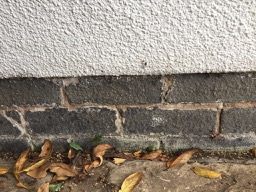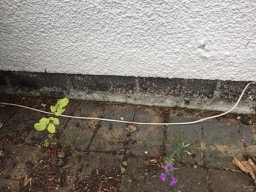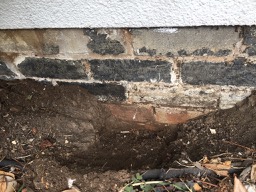So this is in my house rather than workshop (ok a part of the house is a workshop!) but couldn't see where else to ask you experienced builders/architects if you can advise me on due diligence.
Had a cold call from House Guard, offering a damp survey to see if my insulation (blown rockwool) was allowing damp through, so thought no harm in getting their report. The guy came, equipped with a two-point moisture meter, rather the sort of thing one uses for wood. I saw him do the measurements so there was no sleight of hand. The readings on the old part of the house, about 60 years old, were: 30% in skirting boards, 15% on walls immediately over, dropping to 8% 50-60 cm above, dropping to negligible at 150 cm. The 20-year old part of the house (a big extension) showed no damp problems.
Conclusion was that there was no problem with the rockwool insulation, but that the 1960s-era bitumen damp-proof course was failing and needed replacing. This seems reasonable to me, is this right?
Of course they want to do the work. The walls are brick, with 1 or 2 courses visible before the DPC, this was bitumen covered originally but this has cracked and the mortar needs pointing.Above this the whole house is stucco covered, which needs some attention but is generally fairly good condition. The process would be drilling holes in the mortar, injecting the product "secoMUR", repointing brickwork all round then using black secoMUR to seal and replace the bitumen up to the start of the stucco.
The perimeter needing treatment is 30 m. and the price quoted is £3000. It would be about 2 days work for the team (no idea how big the team is).
My questions are
1. Does the diagnosis seem correct?
2. Is this the appropriate treatment for replacing a DPC in an existing building?
3. Is the price quoted about ballpark, cheap or expensive?
I'd be very grateful for guidance, comments and cautions.
Keith
Had a cold call from House Guard, offering a damp survey to see if my insulation (blown rockwool) was allowing damp through, so thought no harm in getting their report. The guy came, equipped with a two-point moisture meter, rather the sort of thing one uses for wood. I saw him do the measurements so there was no sleight of hand. The readings on the old part of the house, about 60 years old, were: 30% in skirting boards, 15% on walls immediately over, dropping to 8% 50-60 cm above, dropping to negligible at 150 cm. The 20-year old part of the house (a big extension) showed no damp problems.
Conclusion was that there was no problem with the rockwool insulation, but that the 1960s-era bitumen damp-proof course was failing and needed replacing. This seems reasonable to me, is this right?
Of course they want to do the work. The walls are brick, with 1 or 2 courses visible before the DPC, this was bitumen covered originally but this has cracked and the mortar needs pointing.Above this the whole house is stucco covered, which needs some attention but is generally fairly good condition. The process would be drilling holes in the mortar, injecting the product "secoMUR", repointing brickwork all round then using black secoMUR to seal and replace the bitumen up to the start of the stucco.
The perimeter needing treatment is 30 m. and the price quoted is £3000. It would be about 2 days work for the team (no idea how big the team is).
My questions are
1. Does the diagnosis seem correct?
2. Is this the appropriate treatment for replacing a DPC in an existing building?
3. Is the price quoted about ballpark, cheap or expensive?
I'd be very grateful for guidance, comments and cautions.
Keith













































